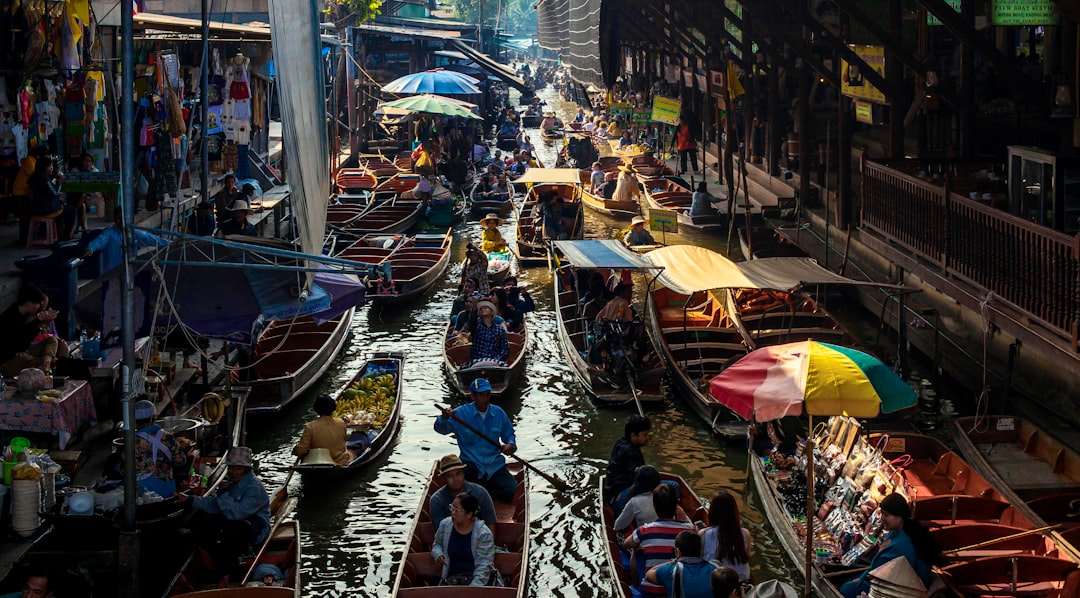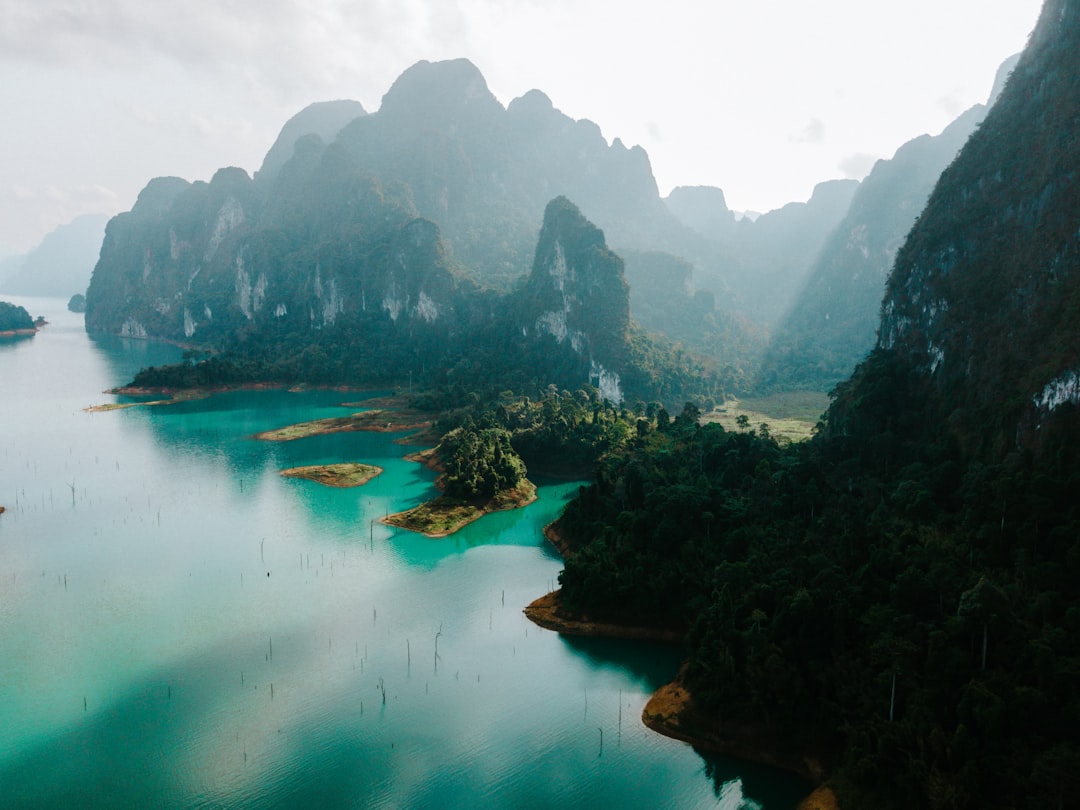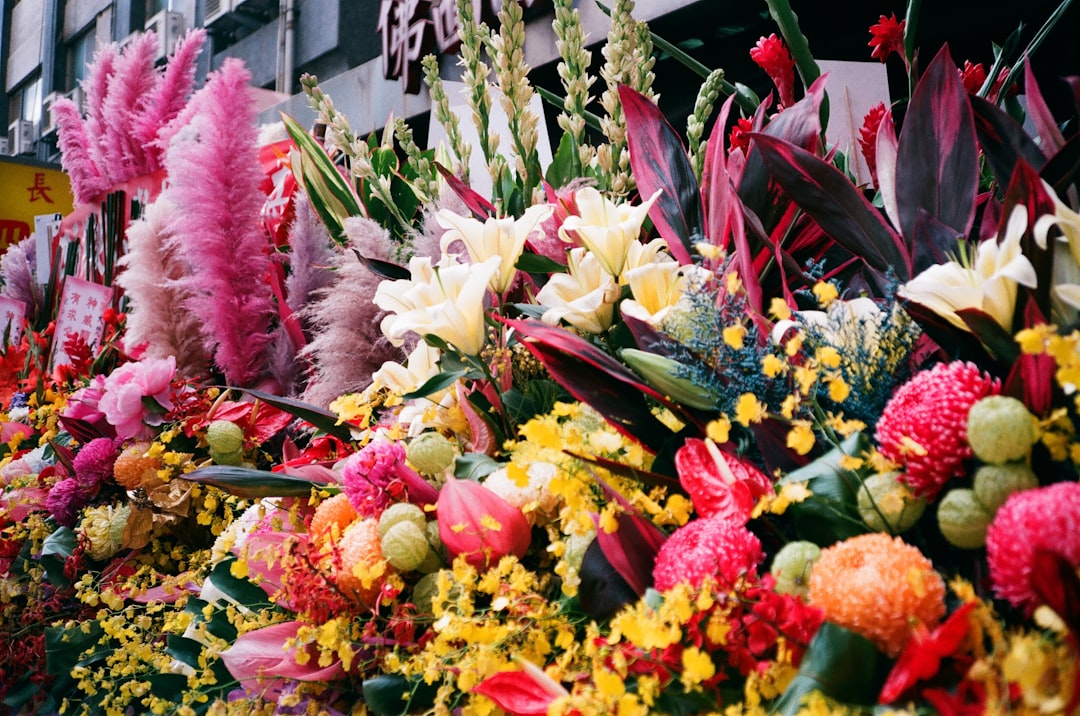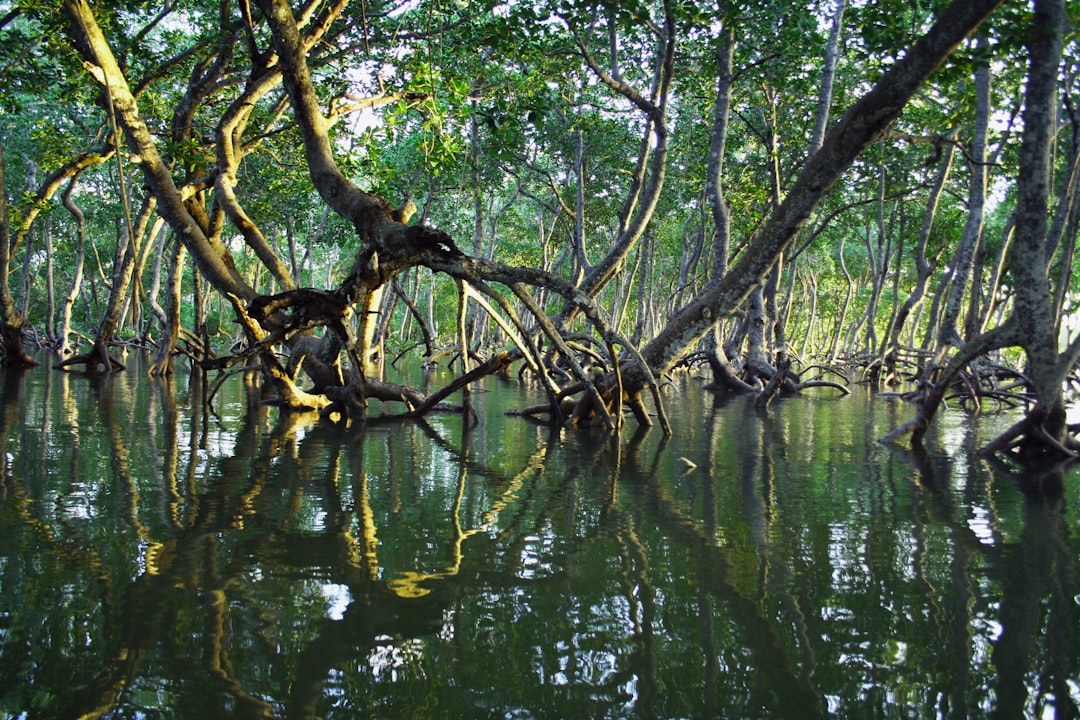Escape the Crowds: 5 Scenic Day Trips From Bangkok for Culture, Nature & Serenity
Escape the Crowds: 5 Scenic Day Trips From Bangkok for Culture, Nature & Serenity - Explore the Floating Markets of Damnoen Saduak

Just a couple hours outside of Bangkok lies one of Thailand's most iconic attractions - the floating markets of Damnoen Saduak. This vibrant scene transports you back in time to a way of life that revolved around bustling canals and wooden boats piled high with fresh produce.
Arriving early in the morning is key to experiencing Damnoen Saduak before the crowds descend. As the sun peeks over the horizon, the canals come alive with activity. Boats begin to cruise slowly through the muddy waters, each laden with fruits, vegetables, and spices. Vendors call out their wares, hoping to draw in customers on the shore. Locals expertly paddle their slender canoes through the traffic, stopping to barter and chat with sellers. The air is rich with the scents of grilled meat and spices.
Wandering the market by boat offers an immersive experience you simply can't get from land. Climb aboard a long wooden boat with a raised bow. Your guide will expertly maneuver through the action, pausing when you want to purchase something or take a photo. Watch as vendors paddle up alongside, dangling succulent mangoes or pungent durian in front of you. Grab sticky rice and mango - the quintessential Thai treat - for a tasty breakfast. With the wind in your hair and the smell of exotic fruits enveloping you, it's easy to feel transported to another time.
The most iconic sight is the rows of stilted wooden shophouses lining the canals. Here you can stop to peruse handicrafts, souvenirs, and other goods not found on the boats. The architecture provides a glimpse into traditional Thai life, where the canal was the lifeblood of the community. Make sure to peek inside ground floor windows to see locals dining or watching TV, going about daily life seemingly oblivious to the chaos outside.
What else is in this post?
- Escape the Crowds: 5 Scenic Day Trips From Bangkok for Culture, Nature & Serenity - Explore the Floating Markets of Damnoen Saduak
- Escape the Crowds: 5 Scenic Day Trips From Bangkok for Culture, Nature & Serenity - See Ancient Khmer Ruins at Phanom Rung Historical Park
- Escape the Crowds: 5 Scenic Day Trips From Bangkok for Culture, Nature & Serenity - Hike to the Seven-Tiered Erawan Waterfall
- Escape the Crowds: 5 Scenic Day Trips From Bangkok for Culture, Nature & Serenity - Marvel at Hellfire Pass and the Bridge on the River Kwai
- Escape the Crowds: 5 Scenic Day Trips From Bangkok for Culture, Nature & Serenity - Discover the Royal retreat at Bang Pa-In Summer Palace
- Escape the Crowds: 5 Scenic Day Trips From Bangkok for Culture, Nature & Serenity - Escape to the Mangrove Forests of Ao Khung Kraben
- Escape the Crowds: 5 Scenic Day Trips From Bangkok for Culture, Nature & Serenity - Visit the Seaside Town of Pattaya for Seafood and Nightlife
- Escape the Crowds: 5 Scenic Day Trips From Bangkok for Culture, Nature & Serenity - Relax on the Untouched Beaches of Rayong
Escape the Crowds: 5 Scenic Day Trips From Bangkok for Culture, Nature & Serenity - See Ancient Khmer Ruins at Phanom Rung Historical Park

Nestled in the lush countryside of northeast Thailand lies one of the most breathtaking and evocative Khmer ruins outside of Cambodia. Dating back to the Angkor period between the 10th and 13th centuries, Phanom Rung Historical Park transports visitors back to the ancient Khmer civilization that once dominated the region. As the largest and best restored Khmer monument in Thailand, Phanom Rung provides an awe-inspiring glimpse into the empire's architectural magnificence and intricate artistic style.
Like the famed temples of Angkor Wat, Phanom Rung was originally a Hindu temple that was later converted into a Buddhist temple. The buildings are constructed of sandstone and laterite, situated on top of an extinct volcano known as Prasat Hin Khao Phanom Rung. As you climb the steep stairs to the main promenade, the sheer size and scale of the complex becomes apparent. The primary prasat (tower) soars nearly 40 meters into the blue sky, a testament to the advanced engineering capabilities of the Khmer architects. Intricate carvings of Hindu deities still adorn the bas reliefs, recalling the rich iconography of a faith that has long faded.
Yet what is most striking about Phanom Rung is how the structures seem to rise directly out of the earth. The buildings are perfectly oriented to align with the sun at solstices and equinoxes, emphasizing the integral connection between humans, nature, and the divine. During the annual Phanom Rung Festival held each April, thousands flock here to witness the spectacular sunset alignment where the last rays of the setting sun pierce straight through 15 different doorways. The interplay of light and shadow creates an ethereal experience that reinforces why this site held such ritual significance to its original inhabitants.
Wandering the sprawling complex today, try to imagine it as it once was, with robed priests chanting Sanskrit mantras, devout pilgrims flocking to worship, and vivid paint bringing the stone carvings to life. While Phanom Rung today lacks some of the grandiose scale of Angkor Wat, in some ways its smaller size allows visitors to connect on a more intimate level. One can almost feel the power and history reverberating through the stones.
Escape the Crowds: 5 Scenic Day Trips From Bangkok for Culture, Nature & Serenity - Hike to the Seven-Tiered Erawan Waterfall

Rising majestically through the lush jungles of Erawan National Park, the seven-tiered Erawan Waterfall beckons visitors to leave behind the chaos of Bangkok and enter a sanctuary of natural tranquility. Each of the falls has its own unique characteristics and appeal, linked together by trails that wind through the vibrant green rainforest. Prepare for a moderate hike of around 1.5km each way, with stunning scenery and pools ideal for swimming along the way.
The first three tiers feature powerful cascades that crash into emerald pools perfect for taking refreshing dips on a hot day. Swim beneath the spray as water tumbles from above, the negative ions invigorating your senses. Tier two is particularly stunning, with water flowing down a near-vertical cliff shrouded in vines. Watch as the falls shift in shape and power throughout the year, swelling most intensely during the rainy season. The smooth rocks and relatively shallow pools make these lower levels ideal for families.
The trail transitions to more of a staircase as you continue upwards, requiring some scrambling over rocks and tree roots. The quieter middle tiers allow meditation beneath umbrella-like trees as gentle cascades trickle down mossy stones. Starting at tier five, be prepared for crowds of locals and tourists who flock here to pay respects to the deity said to reside in the falls. Offer lotus blossoms and incense at the spirit shrine before ascending to the top.
The crowning seventh tier lives up to its billing, a 50m drop that crashes into a perfect turquoise pool begging for a swim. This sublime finale makes the entire hike worthwhile. Arrive early to beat the crowds, claim a rocky perch, and become hypnotized by the sounds and mists of Erawan’s highest cascade. The surrounding jungle muffles any noise from below, allowing total immersion in the sights, sensations, and stillness of this natural wonder. Dappled sunlight filters through the canopy, creating a cathedral-like aura.
Escape the Crowds: 5 Scenic Day Trips From Bangkok for Culture, Nature & Serenity - Marvel at Hellfire Pass and the Bridge on the River Kwai
Nestled deep in the verdant jungles of western Thailand lies a sobering testament to the resilience of human spirit and fragility of life. Hellfire Pass and the Bridge on the River Kwai serve as haunting reminders of the tens of thousands of Allied prisoners of war and Asian civilian laborers who perished at the hands of the Imperial Japanese Army during construction of the notorious Death Railway. A visit to the museum and memorials lets you reflect on their sacrifice and will likely leave you speechless.
As you walk the wooden boardwalks through Hellfire Pass, it’s easy to imagine the backbreaking labor required to cut this massive gorge through solid mountain rock. Working under inhumane conditions with primitive tools, malnourished prisoners were forced to work 16-18 hours a day clinging to makeshift bamboo scaffolding over the treacherous ravine. The ingeniously engineered railroad traversed over 400 km of dense jungle, crosing harrowing chasms and rushing rivers, to connect Thailand and Burma. Speed was valued over human life, with prisoners succumbing to cholera, malaria, starvation, or pure exhaustion. It's estimated over 100,000 perished in what's considered one of the most brutal labor projects of WWII.
The eerie silence that hangs over Hellfire Pass today belies the site’s sinister name, which comes from the ghostly glow of bamboo bonfires and oil lamps that allowed for 24 hour construction. The excellent Hellfire Pass Memorial Museum chronicles personal stories and artifacts that provide perspective on the prisoners’ daily struggle for survival. Don’t miss the deeply moving ANZAC Day Dawn Service held each April 25th to honor the fallen.
Down river, the Bridge on the River Kwai still stands as an engineering marvel built entirely by hand under unfathomable conditions. Visitors can walk its 415m expanse, feeling humbled by the titanic effort required to construct the 11 steel spans back in 1943 without any heavy machinery. While the curved wooden bridge famously depicted in the classic film The Bridge on the River Kwai is fictional, the area evokes what it may have felt like for prisoners gazing up at the Kwai Noi’s towering cliffs knowing that freedom lay just beyond its grasp.
Some argue the story of the Death Railway often focuses too much on prisoner suffering while overlooking the plight of the nearly 90,000 Asian civilian laborers who were forced into service. A visit to the understated Jeath War Museum in nearby Kanchanaburi town helps acknowledge their sacrifices while serving as a solemn reminder of the devastating toll inflicted by Imperial Japan’s wartime atrocities.
Escape the Crowds: 5 Scenic Day Trips From Bangkok for Culture, Nature & Serenity - Discover the Royal retreat at Bang Pa-In Summer Palace
Just a short drive from Bangkok lies Bang Pa-In Summer Palace, a tranquil riverside escape that provides a window into the lives of 19th century Siamese royalty. Away from the crowds and chaos of the capital, the palace’s exquisite architecture and painstakingly manicured grounds offer a serene glimpse into traditional court life. Wandering among pavilions built for kings, queens, and consorts provides insight into the power dynamics and intrigues that shaped Siam at the turn of the 20th century.
Of Bang Pa-In’s collection of lavish buildings, the standout is undoubtedly the Aisawan Thiphya-Art Palace, an ornate two-story confection mixing Thai, Chinese, Vietnamese and Western architectural elements. Known as the “Divine Seat of Personal Freedom”, the palace was built for King Chulalongkorn in the 1880s as a place for relaxation and entertaining female companions. Intricately carved wooden pillars hold up the soaring roof, while vibrantly painted murals depicting Ramayana myths adorn the inner walls. The breezy open-air layout captures river breezes to naturally cool the palace without the use of fans.
Just across the pond lies the smaller but even more elegant Wehart Chamrunt Palace, gifted by King Chulalongkorn to his beloved chief consort. Ethereal colors and patterns adorn every surface, merging Victorian influences with traditional Thai craftsmanship. Delicate hand-painted Ramayana scenes grace the outside shutters, while inside Grand Palace-worthy mother-of-pearl inlay shimmers across lacquered cabinets and thrones.
Perhaps most photogenic is the stunning Chinese-style Ho Withun Thasana pavilion perched at the edge of a small lake. Its bright red and gold color scheme reflects across the rippling waters, creating a scene reminiscent of a Chinese postcard. The attention to detail is evident in the intricate carved dragons swirling across the roofline and colourful paintings of Chinese immortals gracing the interior walls. This structure offered an open-air venue for enjoying light meals or after-dinner dance performances, often featuring princess consorts.
Wandering the sprawling landscape, further treasures await around each corner. Peek inside the Victorian-influenced observatory to view 19th century astronomy instruments gifted by European royals. Pose on the elegant marble Barhi Pavilion jutting out into the river, built to resemble a farmhouse dairy barn seen by King Chulalongkorn on a visit to Europe. Admire the multi-tiered roof of the Thai-style Lacquer Pavilion, or snap candids against the Trojan columns of the European-inspired Observation Tower.
Escape the Crowds: 5 Scenic Day Trips From Bangkok for Culture, Nature & Serenity - Escape to the Mangrove Forests of Ao Khung Kraben

Just a 90 minute drive from Bangkok, the mangrove forests of Ao Khung Kraben transport visitors to a hidden aquatic wonderland far removed from the chaos of the city. Located within the Laem Phak Bia Environment Research and Development Project, this nature reserve protects one of Thailand’s best preserved mangrove ecosystems. Gliding through intricate waterways shaded by lush canopy reminds us of the wondrous beauty nature can create when left unspoiled by human intervention.
As our long-tail boat hums gently along, our guide explains how mangroves uniquely adapt to their brackish environment along tidal flats and estuaries. Emerging aerial roots filter out salt and allow oxygen absorption, while propagules facilitate reproduction and dispersion. We drift slowly past trees laden with fuzzy pods, gazing up at a green ceiling teeming with life. Birds call out from above, while fish breach the surface beside us.
Our captain steers us along ever-narrowing channels until we emerge into hidden lagoons surrounded completely by verdant green. Reaching out, we trails our hands along leaves and watch tiny crabs scurry up trunks. The biodiversity here astounds, with over 200 species of fauna and 90 species of flora occupying this mangrove haven. Turning off the engine, we sit in silence and feel at one with nature.
As avid snorkelers, we’re excited when our guide invites us to jump into the protected shallow waters. Equipped with masks, we’re amazed at the tranquility and clarity, so unlike the murky mangrove swamps depicted in films. Bright tropical fish weave between submerged roots as tiny bivalves filter feed. Sponges, sea squirts, and anemones add brilliant pops of color across the sandy bottom. We lose track of time floating gently, embracing this nourishing serenity.
Back on board, our guide explains the critical benefits mangroves provide and why they’re threatened worldwide. They protect inland areas from storm surge, provide nurseries for young fish, and absorb immense amounts of carbon. Sadly, development and aquaculture continue to destroy these fragile ecosystems at alarming rates. That makes preserves like Ao Khung Kraben all the more precious.
Escape the Crowds: 5 Scenic Day Trips From Bangkok for Culture, Nature & Serenity - Visit the Seaside Town of Pattaya for Seafood and Nightlife
With its bustling beaches, famous seafood, and raucous nightlife, the seaside town of Pattaya offers an indulgent escape from Bangkok's chaos. Located just a two-hour drive southeast from the capital, this former sleepy fishing village morphed into a tourist playground starting in the 1960s when American GIs came for Rest & Recreation during the Vietnam War. While Pattaya today caters heavily to package tourists and has a seedy undertone, it remains a popular Thai weekend getaway with ample diversions for visitors seeking sun, surf, and after-dark excitement.
Pattaya Beach Road parallels the curving shoreline, packed with resorts, restaurants, bars and shopping plazas. Wander south along its bustling promenade to see Pattaya transformed into a pedestrian zone each evening, with street performers, vendors, and live music spilling into the streets. Europe-worthy beach chairs line the sand, available to rent for relaxing with a fresh coconut or ice-cold Singha. When hunger strikes, sample sizzling seafood skewers from ubiquitous beachside grills, or sit down for American-sized portions of grilled lobster, jumbo prawns, and whole snapper at one of the restaurants with prime oceanfront views. After the sun dips below the horizon, the lights come on and the tempo shifts to EDM beats pumping as beach clubs and go-go bars crank up for debaucherous all-night parties.
Venture across the headland to quieter Jomtien Beach to enjoy Pattaya's seaside scenery minus the seedier undertones. Wide sandy stretches are fringed by palm trees rather than highrises, with a laidback vibe and family-friendly watersports scene. Kiteboarders catch air against the blue sky, while parasailers get lifted hundreds of feet aloft for panoramic vistas back to shore. Take a high-speed cruise along the coast to spot small islands and rocky outcrops that comprise Pattaya's seascape. Charter a private longtail boat for snorkeling in the Ang Sila Islands Marine National Park just offshore, where translucent waters showcase coral and plentiful marine life.
Escape the Crowds: 5 Scenic Day Trips From Bangkok for Culture, Nature & Serenity - Relax on the Untouched Beaches of Rayong
Just beyond Pattaya along Thailand's eastern Gulf coast lies Rayong Province, home to some of the country's most pristine and peaceful beaches. While many tourists associate this stretch of coastline with industrialareas and oil refineries, hidden gems await those willing to venture off the beaten path. Rayong's sparsely visited shores offer the chance to experience an authentically local slice of Thai seaside life, without the crowds and consumerism overtaking resort destinations.
One prime example is Mae Ramphueng Beach, a 12 km sandy arc fringed by casuarina pines and dotted with photogenic fishing boats. Waves gently lap the shore as locals cast nets and lines just offshore, illustrating the area's enduring connection to the sea. Thatched roof seafood shacks serve the catch of the day simply grilled or steamed, with fiery dipping sauces complementing the subtle natural flavors. While weekends draw Bangkok daytrippers down, weekdays belong to local families who set up picnics and build sandcastles along the expansive beach. Resort development is essentially nonexistent, and visitors need to bring their own supplies or procure them from nearby towns.
Further south near the Cambodian border, Klang Beach ('Monkey Beach') earns its nickname from the resident troupe of crab-eating macaques who inhabit the shoreline. They serve as both a hazard and delight, sneaking snacks but also providing endless entertainment as they groom, wrestle, and care for their young. While mischievous monkeys can make swimming dodgy, the soft sand and peaceful atmosphere make Klang ideal for whiling away hours under swaying palms. The protected cove offers shallow waters perfect for little ones to splash about. As the sun sinks low, beachside seafood stalls fire up grills and the monkeys settle down for the night high in their arboreal perches.
